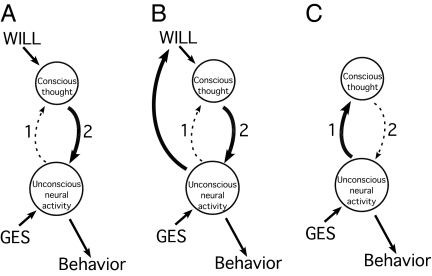Fig. 1.
Models for the flow of information between unconscious neural activity and conscious thought. In A, the commonly accepted model is shown whereby WILL influences conscious thought and, in turn, unconscious neural activity, to direct behavior. The difficulty with this model is that there is no causal component directing WILL. In B, a causal component for WILL is introduced; however WILL now simply reflects unconscious neural activity and GES (genes, environment, and stochasticism). That is, WILL loses its “freedom.” In C, WILL is dispensed with, and conscious thought is simply a reflection of unconscious neural activity and GES. Conscious thought is now primarily a means of following—more than a means of influencing—the direction of behavior by unconscious neural activity. This subservient role of conscious thought in directing behavior in model C, is indicated by the dotted arrow 2 (contrasting with the solid line for the corresponding arrow in A and B).

